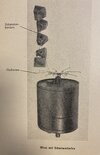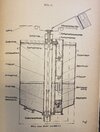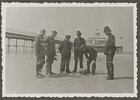Formerly a underwater weapon, but by the RAF categorized under aircraft bombs, so therefore placed here.
Towards the end of 1939, a Plan known as W.A.16, with the code name 'Royal Marine ', was devised by the War Cabinet with the object of reducing Germany's inland waterway traffic to the maximum possible extent by laying mines from aircraft. The mines were the so called ‘W’ (Water) bombs and as far as I know 3 Marks were produced.
The Mark I was made up of a cylindrical casing of 10 inches diameter and 15 inches long, filled with a charge of 20 lb. TNT , the total weight being 35 lb. The mine had a negative buoyancy, and to it were attached by lines, a number of cork floats. These corks were contained in a small chamber at the top of the bomb, which also contained the firing device-a number of wires arranged like the ribs of an umbrella. These were held together by a lid which also retained the corks but were arranged so that, on the removal of the lid they opened out radially, forming a number of projecting ' whiskers ‘. Two delay devices in the form of soluble plugs were fitted: the first, after two or three minutes in the water, freed the lid, releasing the contact wires and corks which then held the bomb suspended at a depth of some 3 feet and free to float with the current of the stream. The second was intended - to sink the mine after a lapse of 6, 18 or f48 hours (according to the type of plug fitted), so that it became inoperative in neutral waters. This type was intended for use in rivers. The German name for this mine was Flußmine 480 (e).
For the still waters of canals, a Mark II pattern was designed in which the corks were attached directly to the mine. At the bottom was a 5 lb. sinker and 6 feet of mooring cable. After entry the sinker was freed by a soluble plug, and moored the mine 6 feet from the bottom. As the average depth of a canal was 9 feet, it was thus held some 3 feet from the surface.
A third type (Mark III) was intended to destroy pontoon bridges, whose draught is about 1 foot. The Mark III mine, by means of directly attached corks, floated just below the surface, and was intended to drift into contact with the bridge. In all Marks, any contact with the radial wires completed an electric circuit supplied by a small battery, firing an electric detonator and the main charge. All bombs were fitted with a small drogue, designed by the Royal Engineers and Signals Board, to check their impact.
But in the German Bomb Disposal Handbook Belerungsblattern über Beseitigung feindlicher Abwurfmunition Blatt 1 und 2 is mentioned a larger model named Englische Flugzeugtreibmine ELMT 10 with a content of 10 kg TNT that looks like the Mark I but is 480 mm (18.89 inch) in diameter en 620 mm (24.4 inch) long. The picture is the same as the Flußmine 480 (e) that is mentioned in the German manual D553, Englische Flugzeugtreibmine.
Is the larger version a Mark IV, or is the info in the German Bomb Disposal Handbook wrong?
I am also looking for the complete photo with a 'W" bomb on the Dutch beach at Scheveningen with the German soldier leaning over it and police officers of The Hague (looks like Bobbies) standing near it.
Greetings - Antoon





Towards the end of 1939, a Plan known as W.A.16, with the code name 'Royal Marine ', was devised by the War Cabinet with the object of reducing Germany's inland waterway traffic to the maximum possible extent by laying mines from aircraft. The mines were the so called ‘W’ (Water) bombs and as far as I know 3 Marks were produced.
The Mark I was made up of a cylindrical casing of 10 inches diameter and 15 inches long, filled with a charge of 20 lb. TNT , the total weight being 35 lb. The mine had a negative buoyancy, and to it were attached by lines, a number of cork floats. These corks were contained in a small chamber at the top of the bomb, which also contained the firing device-a number of wires arranged like the ribs of an umbrella. These were held together by a lid which also retained the corks but were arranged so that, on the removal of the lid they opened out radially, forming a number of projecting ' whiskers ‘. Two delay devices in the form of soluble plugs were fitted: the first, after two or three minutes in the water, freed the lid, releasing the contact wires and corks which then held the bomb suspended at a depth of some 3 feet and free to float with the current of the stream. The second was intended - to sink the mine after a lapse of 6, 18 or f48 hours (according to the type of plug fitted), so that it became inoperative in neutral waters. This type was intended for use in rivers. The German name for this mine was Flußmine 480 (e).
For the still waters of canals, a Mark II pattern was designed in which the corks were attached directly to the mine. At the bottom was a 5 lb. sinker and 6 feet of mooring cable. After entry the sinker was freed by a soluble plug, and moored the mine 6 feet from the bottom. As the average depth of a canal was 9 feet, it was thus held some 3 feet from the surface.
A third type (Mark III) was intended to destroy pontoon bridges, whose draught is about 1 foot. The Mark III mine, by means of directly attached corks, floated just below the surface, and was intended to drift into contact with the bridge. In all Marks, any contact with the radial wires completed an electric circuit supplied by a small battery, firing an electric detonator and the main charge. All bombs were fitted with a small drogue, designed by the Royal Engineers and Signals Board, to check their impact.
But in the German Bomb Disposal Handbook Belerungsblattern über Beseitigung feindlicher Abwurfmunition Blatt 1 und 2 is mentioned a larger model named Englische Flugzeugtreibmine ELMT 10 with a content of 10 kg TNT that looks like the Mark I but is 480 mm (18.89 inch) in diameter en 620 mm (24.4 inch) long. The picture is the same as the Flußmine 480 (e) that is mentioned in the German manual D553, Englische Flugzeugtreibmine.
Is the larger version a Mark IV, or is the info in the German Bomb Disposal Handbook wrong?
I am also looking for the complete photo with a 'W" bomb on the Dutch beach at Scheveningen with the German soldier leaning over it and police officers of The Hague (looks like Bobbies) standing near it.
Greetings - Antoon






